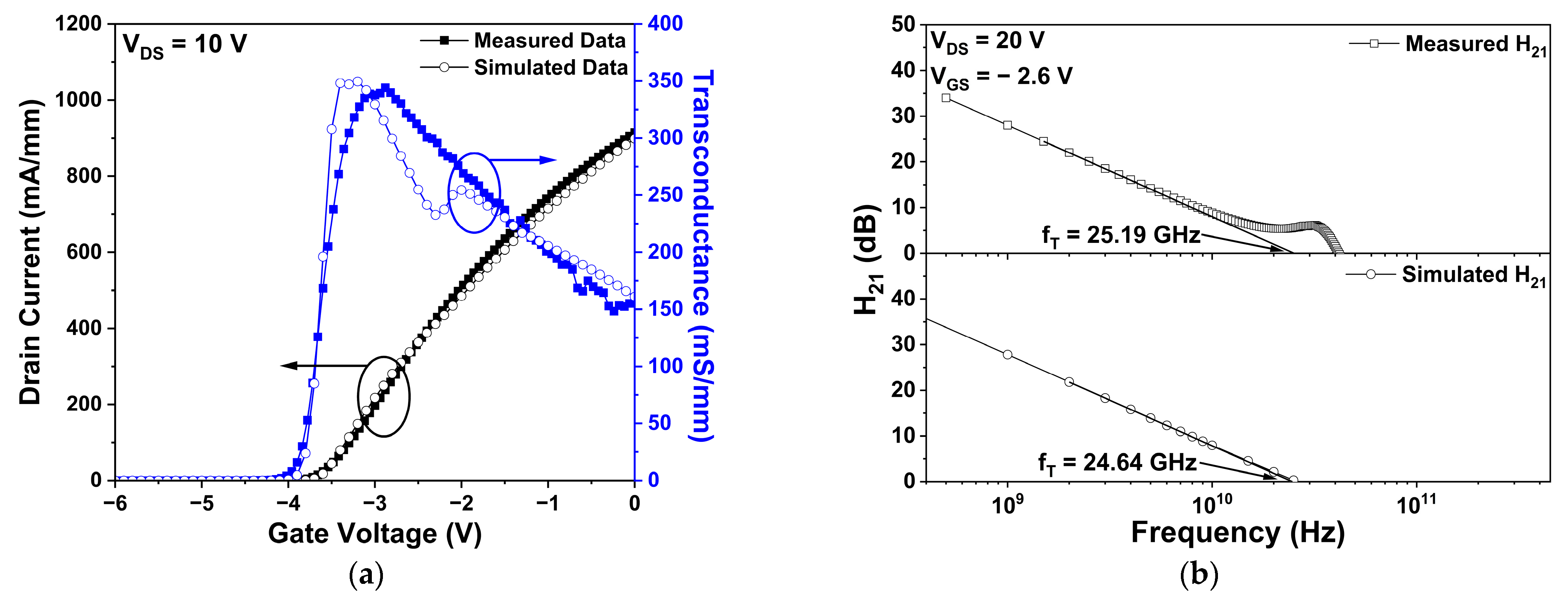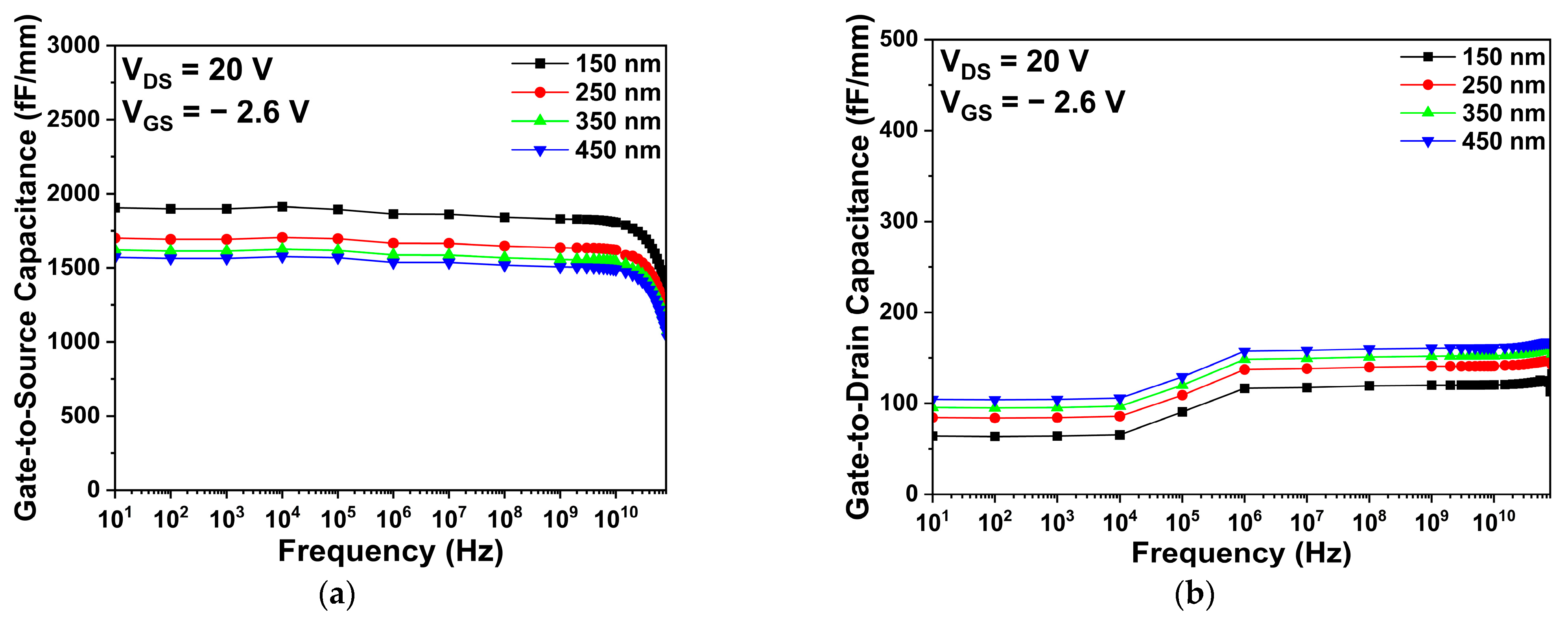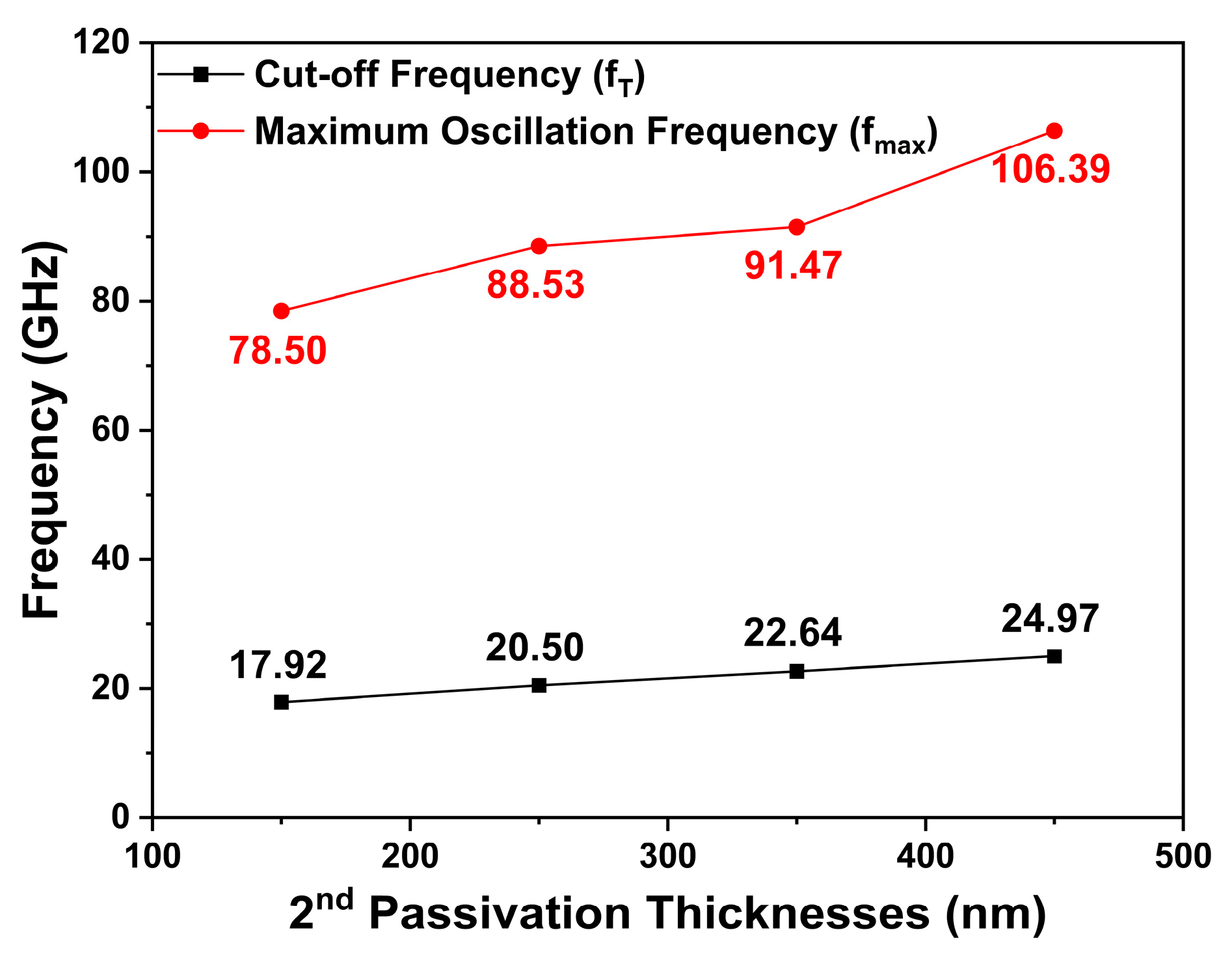Enhanced Operational Characteristics Attained by Applying HfO2 as Passivation in AlGaN/GaN High-Electron-Mobility Transistors: A Simulation Study
Abstract
1. Introduction
2. Materials and Methods
3. Results
3.1. Basic Si3N4 Passivation Structure of HEMT Modeling Verified by Matching the Simulation’s Results with the Measured Data
3.2. Comparative Analysis between HEMTs with Si3N4, HfO2, and Hybrid Passivation Structures
3.2.1. Analysis of DC Characteristics
3.2.2. Analysis of the RF Characteristics
3.3. Determination of the Optimum Second Passivation Thickness for Hybrid Structure
3.3.1. Analysis of the DC Characteristics
3.3.2. Analysis of the RF Characteristics
4. Discussion
5. Conclusions
Author Contributions
Funding
Conflicts of Interest
References
- Zhang, N.Q.; Keller, S.; Parish, G.; Heikman, S.; DenBaars, S.P.; Mishra, U.K. High breakdown GaN HEMT with overlapping gate structure. IEEE Electron Device Lett. 2000, 21, 421–423. [Google Scholar] [CrossRef]
- Meneghini, M.; Rossetto, I.; Santi, C.D.; Rampazzo, F.; Tajalli, A.; Barbato, A.; Ruzzarin, M.; Borga, M.; Canato, E.; Zanoni, E.; et al. Reliability and failure analysis in power GaN-HEMTs: An overview. In Proceedings of the IEEE International Reliability Physics Symposium (IRPS), Monterey, CA, USA, 2–6 April 2017. [Google Scholar]
- Mishra, U.K.; Shen, L.; Kazior, T.E.; Wu, Y.F. AlGaN/GaN HEMTs-an overview of device operation and applications. Proc. IEEE 2002, 90, 1022–1031. [Google Scholar] [CrossRef]
- Del Alamo, J.A.; Joh, J. GaN HEMT reliability. Microelectron. Reliab. 2009, 49, 1200–1206. [Google Scholar] [CrossRef]
- Kim, J.G.; Cho, C.; Kim, E.; Hwang, J.S.; Park, K.H.; Lee, J.H. High Breakdown Voltage and Low-Current Dispersion in AlGaN/GaN HEMTs with High-Quality AlN Buffer Layer. IEEE Trans. Electron Devices 2021, 68, 1513–1517. [Google Scholar] [CrossRef]
- Sodan, V.; Oprins, H.; Stoffels, S.; Baelmans, M.; Wolf, I.D. Influence of Field-Plate Configuration on Power Dissipation and Temperature Profiles in AlGaN/GaN on Silicon HEMTs. IEEE Trans. Electron Devices 2015, 62, 2416–2422. [Google Scholar] [CrossRef]
- Saito, W.; Takada, Y.; Kuraguchi, M.; Tsuda, K.; Omura, I.; Omura, T. High breakdown voltage AlGaN-GaN Power-HEMT design and high current density switching behavior. IEEE Trans. Electron Devices 2003, 50, 2528–2531. [Google Scholar] [CrossRef]
- Shi, N.; Wang, K.; Zhou, B.; Weng, J.; Cheng, Z. Optimization AlGaN/GaN HEMT with Field Plate Structures. Micromachines 2022, 13, 702. [Google Scholar] [CrossRef]
- Saadat, O.I.; Chung, J.W.; Piner, E.L.; Palacios, T. Gate-First AlGaN/GaN HEMT Technology for High-Frequency Applications. IEEE Electron Device Lett. 2009, 30, 1254–1256. [Google Scholar] [CrossRef]
- Ahsan, S.A.; Ghosh, S.; Sharma, K.; Dasgupta, A.; Khandelwal, S.; Chauhan, Y.S. Capacitance modeling in dual field-plate power GaN HEMT for accurate switching behavior. IEEE Trans. Electron Devices 2015, 63, 565–572. [Google Scholar] [CrossRef]
- Kwak, H.T.; Chang, S.B.; Kim, H.J.; Jang, K.W.; Yoon, H.S.; Lee, S.H.; Lim, J.W.; Kim, H.S. Operational Improvement of AlGaN/GaN High Electron Mobility Transistor by an Inner Field-Plate Structure. Appl. Sci. 2018, 8, 974. [Google Scholar] [CrossRef]
- Sohel, S.H.; Xie, A.; Beam, E.; Xue, H.; Razzak, T.; Bajaj, S.; Cao, Y.; Lee, C.; Lu, W.; Rajan, S. Polarization Engineering of AlGaN/GaN HEMT With Graded InGaN Sub-Channel for High-Linearity X-Band Applications. IEEE Electron Device Lett. 2019, 40, 522–525. [Google Scholar] [CrossRef]
- Liu, X.; Chiu, H.C.; Liu, C.H.; Kao, H.L.; Chiu, C.W.; Wang, H.C.; Ben, J.; He, W.; Huang, C.R. Normally-off p-GaN Gated AlGaN/GaN HEMTs Using Plasma Oxidation Technique in Access Region. IEEE J. Electron Devices Soc. 2020, 8, 229–234. [Google Scholar] [CrossRef]
- Kuzmik, J.; Pozzovivo, G.; Abermann, S.; Carlin, J.; Gonschorek, M.; Feltin, E.; Grandjean, N.; Bertagnolli, E.; Strasser, G.; Pogany, D. Technology and Performance of InAlN/AlN/GaN HEMTs with Gate Insulation and Current Collapse Suppression Using ZrO2 or HfO2. IEEE Trans. Electron Devices 2008, 55, 937–941. [Google Scholar] [CrossRef]
- Coltrin, M.E.; Baca, A.G.; Kaplar, R.J. Analysis of 2D transport and performance characteristics for lateral power devices based on AlGaN alloys. ECS J. Solid State Sci. Technol. 2017, 6, S3114–S3118. [Google Scholar] [CrossRef]
- Downey, B.P.; Meyer, D.J.; Katzer, D.S.; Roussos, J.A.; Pan, M.; Gao, X. SiNx/InAlN/AlN/GaN MIS-HEMTs with 10.8THzV Johnson Figure of Merit. IEEE Electron Device Lett. 2014, 35, 527–529. [Google Scholar] [CrossRef]
- Sanyal, I.; Lin, E.; Wan, Y.; Chen, K.; Tu, P.; Yeh, P.; Chyi, J. AlInGaN/GaN HEMTs with High Johnson’s Figure-of-Merit on Low Resistivity Silicon Substrate. IEEE J. Electron Devices Soc. 2020, 9, 130–136. [Google Scholar] [CrossRef]
- Yoon, H.S.; Min, B.G.; Lee, J.M.; Kang, D.M.; Ahn, H.K.; Kim, H.; Lim, J. Microwave Low-Noise Performance of 0.17 µm Gate-Length AlGaN/GaN HEMTs on SiC with Wide Head Double-Deck T-Shaped Gate. IEEE Electron Device Lett. 2016, 37, 1407–1410. [Google Scholar] [CrossRef]
- Silvaco. Material Dependent Physical Models. In Atlas User’s Manual Device Simulation Software; Silvaco Inc.: Santa Clara, CA, USA, 2016; pp. 519–523. [Google Scholar]
- Kim, H.J.; Jang, K.W.; Kim, H.S. Operational Characteristics of Various AlGaN/GaN High Electron Mobility Transistor Structures Concerning Self-Heating Effect. J. Nanosci. Nanotechnol. 2019, 19, 6016–6022. [Google Scholar] [CrossRef]
- Raja, P.V.; Subramani, N.K.; Gaillard, F.; Bouslama, M.; Sommet, R.; Nallatamby, J. Identification of Buffer and Surface Traps in Fe-Doped AlGaN/GaN HEMTs Using Y21 Frequency Dispersion Properties. Electronics 2021, 10, 3096. [Google Scholar] [CrossRef]
- Vitanov, S.; Palankovski, V.; Maroldt, S.; Quay, R. High-temperature modeling of algan/gan hemts. Solid-State Electron. 2010, 54, 1105–1112. [Google Scholar] [CrossRef]
- Lee, J.H.; Choi, J.H.; Kang, W.S.; Kim, D.; Min, B.G.; Kang, D.M.; Choi, J.H.; Kim, H.S. Analysis of Operational Characteristics of AlGaN/GaN HEMT with Various Slant-Gate-Based Structures: A Simulation Study. Micromachines 2022, 13, 1957. [Google Scholar] [CrossRef] [PubMed]
- Belkacemi, K.; Hocine, R. Efficient 3D-TLM modeling and simulation for the thermal management of microwave AlGaN/GaN HEMT used in high power amplifiers SSPA. J. Low Power Electron Appl. 2018, 8, 23. [Google Scholar] [CrossRef]
- Brady, R.G.; Oxley, C.H.; Brazil, T.J. An Improved Small-Signal Parameter-Extraction Algorithm for GaN HEMT Devices. IEEE Trans. Microw. Theory Tech. 2008, 56, 1535–1544. [Google Scholar] [CrossRef]
- Yoon, H.S.; Min, B.G.; Lee, J.M.; Kang, D.M.; Ahn, H.K.; Kim, H.C.; Lim, J.W. Wide head T-shaped gate process for low-noise AlGaN/GaN HEMTs. In Proceedings of the CS MANTECH Conference, Scottsdale, AZ, USA, 18–21 May 2015. [Google Scholar]
- Saito, W.; Nitta, T.; Kakiuchi, Y.; Saito, Y.; Tusda, K.; Omura, I.; Yamaguchi, M. On-Resistance Modulation of High Voltage GaN HEMT on Sapphire Substrate Under High Applied Voltage. IEEE Electron Device Lett. 2007, 28, 676–678. [Google Scholar] [CrossRef]
- Nuttinck, S.; Gebara, E.; Laskar, J.; Harris, H.M. Study of self-heating effects, temperature-dependent modeling, and pulsed load-pull measurements on GaN HEMTs. IEEE Trans. Microw. Theory Tech. 2001, 49, 2413–2420. [Google Scholar] [CrossRef]
- Cioni, M.; Zagni, N.; Selmi, L.; Meneghesso, G.; Meneghini, M.; Zanoni, E.; Chini, A. Electric Field and Self-Heating Effects on the Emission Time of Iron Traps in GaN HEMTs. IEEE Trans. Electron Devices 2021, 68, 3325–3332. [Google Scholar] [CrossRef]
- Jang, K.W.; Hwang, I.T.; Kim, H.J.; Lee, S.H.; Lim, J.W.; Kim, H.S. Thermal analysis and operational characteristics of an AlGaN/GaN High electron mobility transistor with copper-filled structures: A simulation study. Micromachines 2019, 11, 53. [Google Scholar] [CrossRef]
- Kabemura, T.; Ueda, S.; Kawada, Y.; Horio, K. Enhancement of Breakdown Voltage in AlGaN/GaN HEMTs: Field Plate Plus High-k Passivation Layer and High Acceptor Density in Buffer Layer. IEEE Trans. Electron Devices 2018, 65, 3848–3854. [Google Scholar] [CrossRef]
- Hanawa, H.; Onodera, H.; Nakajima, A.; Horio, K. Numerical Analysis of Breakdown Voltage Enhancement in AlGaN/GaN HEMTs with a High-k Passivation Layer. IEEE Trans. Electron Devices 2014, 61, 769–775. [Google Scholar] [CrossRef]
- Cheng, J.; Rahman, M.W.; Xie, A.; Xue, H.; Sohel, S.H.; Beam, E.; Lee, C.; Yang, H.; Wang, C.; Cao, Y.; et al. Breakdown Voltage Enhancement in ScAlN/GaN High-Electron-Mobility Transistors by High-k Bismuth Zinc Niobate Oxide. IEEE Trans. Electron Devices 2021, 68, 3333–3338. [Google Scholar] [CrossRef]
- Chung, J.W.; Hoke, W.E.; Chumbes, E.M.; Palacios, T. AlGaN/GaN HEMT with 300-GHz fmax. IEEE Electron Device Lett. 2010, 31, 195–197. [Google Scholar] [CrossRef]











| Parameters | Value (μm) |
|---|---|
| ① | 1.5 |
| ② | 0.5 |
| ③ | 0.8 |
| ④ | 1.0 |
| ⑤ | 0.15 |
| ⑥ | 0.44 |
| Field-plate thickness | 0.44 |
| 1st passivation | 0.05 |
| 2nd passivation | 0.25 |
| AlGaN barrier | 0.025 |
| GaN buffer | 2 |
| Nucleation layer | 0.2 |
| Parameters | Units | GaN | AlGaN |
|---|---|---|---|
| Bandgap energy | eV | 3.39 | 3.88 |
| Electron affinity | eV | 4.2 | 2.3 |
| Relative permittivity | - | 9.5 | 9.38 |
| Low field mobility model | - | FMCT Mobility Model | |
| High field mobility model | - | GANSAT Mobility Model | |
| Electron saturation velocity | cm/s | 1.9 107 | 1.12 107 |
| Hole saturation velocity | cm/s | 1.9 107 | 1.00 106 |
| Electron SRH lifetime | s | 1.0 10–8 | 1.0 10–8 |
| Hole SRH lifetime | s | 1.0 10–8 | 1.0 10–8 |
| Parameters | Units | GaN | AlGaN | SiC-4H |
|---|---|---|---|---|
| - | 1.3 | 0.4 | 3.3 | |
| - | 0.43 | 0 | 1.61 |
| Parameters | Units | Si3N4 | HfO2 | Hybrid | |
|---|---|---|---|---|---|
| First/second passivation thickness | nm | 50/250 | 50/250 | 50/250 | 50/350 |
| ) | Ω-mm | 4.02 | 3.84 | 3.97 | 4.16 |
| ) | V | 232.47 | 276.27 | 268.41 | 267.57 |
| ) | GHz | 24.64 | 10.17 | 20.50 | 22.64 |
| ) | GHz | 110.27 | 48.72 | 88.53 | 91.47 |
| Standard lateral figure-of-merit (LFOM) | MW/mm | 13.44 | 19.93 | 18.15 | 17.21 |
| Johnson’s figure-of-merit (JFOM) | THz-V | 5.73 | 2.81 | 5.50 | 6.06 |
Disclaimer/Publisher’s Note: The statements, opinions and data contained in all publications are solely those of the individual author(s) and contributor(s) and not of MDPI and/or the editor(s). MDPI and/or the editor(s) disclaim responsibility for any injury to people or property resulting from any ideas, methods, instructions or products referred to in the content. |
© 2023 by the authors. Licensee MDPI, Basel, Switzerland. This article is an open access article distributed under the terms and conditions of the Creative Commons Attribution (CC BY) license (https://creativecommons.org/licenses/by/4.0/).
Share and Cite
Choi, J.-H.; Kang, W.-S.; Kim, D.; Kim, J.-H.; Lee, J.-H.; Kim, K.-Y.; Min, B.-G.; Kang, D.M.; Kim, H.-S. Enhanced Operational Characteristics Attained by Applying HfO2 as Passivation in AlGaN/GaN High-Electron-Mobility Transistors: A Simulation Study. Micromachines 2023, 14, 1101. https://doi.org/10.3390/mi14061101
Choi J-H, Kang W-S, Kim D, Kim J-H, Lee J-H, Kim K-Y, Min B-G, Kang DM, Kim H-S. Enhanced Operational Characteristics Attained by Applying HfO2 as Passivation in AlGaN/GaN High-Electron-Mobility Transistors: A Simulation Study. Micromachines. 2023; 14(6):1101. https://doi.org/10.3390/mi14061101
Chicago/Turabian StyleChoi, Jun-Hyeok, Woo-Seok Kang, Dohyung Kim, Ji-Hun Kim, Jun-Ho Lee, Kyeong-Yong Kim, Byoung-Gue Min, Dong Min Kang, and Hyun-Seok Kim. 2023. "Enhanced Operational Characteristics Attained by Applying HfO2 as Passivation in AlGaN/GaN High-Electron-Mobility Transistors: A Simulation Study" Micromachines 14, no. 6: 1101. https://doi.org/10.3390/mi14061101
APA StyleChoi, J.-H., Kang, W.-S., Kim, D., Kim, J.-H., Lee, J.-H., Kim, K.-Y., Min, B.-G., Kang, D. M., & Kim, H.-S. (2023). Enhanced Operational Characteristics Attained by Applying HfO2 as Passivation in AlGaN/GaN High-Electron-Mobility Transistors: A Simulation Study. Micromachines, 14(6), 1101. https://doi.org/10.3390/mi14061101





